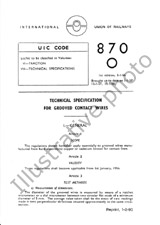We need your consent to use the individual data so that you can see information about your interests, among other things. Click "OK" to give your consent.

UIC B126/DT441-1ed.
Braking Questions - Optimization of the contour of composite brake blocks to reduce the equivalent conicity - Synthesis of the results of final phase results
Translate name
STANDARD published on 1.6.2014
The information about the standard:
Designation standards: UIC B126/DT441-1ed.
Publication date standards: 1.6.2014
SKU: NS-1190184
The number of pages: 42
Approximate weight : 126 g (0.28 lbs)
Country: International technical standard
Category: Technical standards UIC
Annotation of standard text UIC B126/DT441-1ed. :
Several investigations in the in-service performance of composite brake blocks showed that the use of such blocks results in a different wear pattern of the wheel profile in comparison to cast iron blocks. One of the effects is the increase of the equivalent conicity which is a parameter to assess the running stability characteristics of a vehicle. Especially with some tested blocks of sinter material the equivalent conicity changes relatively fast.
In previous investigations the idea had risen that the contour of the brake block plays an important role in the wear pattern of the wheel profile and thus it was expected that the modification of the block shape could have beneficial effects for the wheel profile. Therefore in the beginning of 2009 UIC decided to start a project to optimize the shape of the brake block in order to prevent the equivalent conicity to rise. In the first phase of this project, test bench test were carried out to simulate the wheel tread wear in order to understand the problem. It came out that indeed the brake blocks influence the wear of the wheel profile but the test bench test were not an appropriate method to investigate the phenomenon. The results are reported in B 126/DT 433.
This report intents to describe and summarize the activities carried out in the second phase of the project and draw some finalizing conclusions. In this second phase of the project the influence of various brake block materials, shapes and positions on wheels in service was investigated on the EuropeTrain. Further (non)destructive investigations on the wheel treads material were carried out to get more insight in the mechanisms that play a role in the tread wear. The investigations gave the insight that the wheel-rail interaction plays an important role in the wear of the wheelprofile and the important differences between the brake block material, resulting in different wear rates and heat related deterioration, occur. The investigations indicate that the risk of thermal cracking might increase when using LL-brake blocks, this should be taken into account in the maintenance plans and when making LCC analysis. No major advantage of the use of modified brake block positions or shapes could be demonstrated; therefore it is not recommended to development this idea of changing the block shape as a measure to optimize LCC.
"+
"
Name:Fragen des Bremswesens - Optimierung der Verbundstoffsohlenform zur Reduzierung der äquivalenten Konizität - Zusammenfassung der Ergebnisse der Abschlussphase|
Untersuchungen des Betriebsverhaltens von Verbundstoffsohlen zeigten, dass diese andere Verschleißmuster an Radprofilen erzeugen als gusseiserne Bremssohlen. Unter anderem war eine Zunahme der äquivalenten Konizität festzustellen, einem Parameter, mit dem die Laufruhe eines Fahrzeugs bewertet wird. Vor allem die Versuche mit Bremssohlen aus gesintertem Material zeigten einen relativ raschen Anstieg der äquivalenten Konizität.
In früheren Studien wird postuliert, dass die Form der Bremssohlen ausschlaggebend für das Verschleißmuster am Radprofil ist und daher ging man davon aus, dass sich eine Änderung der Bremssohlenform positiv auf das Radprofil auswirken könnte. Anfang 2009 beschloss die UIC daher die Einleitung eines Projektes zur Optimierung der Bremssohlenformen, um diesen Anstieg der äquivalenten Konizität zu verhindern. In der ersten Projektphase wurden Prüfstandsversuche zur Simulation des Radprofilsverschleißes durchgeführt, um das Problem zu erfassen. Sie ergaben, dass die Bremssohle den Radprofilverschleiß beeinflusst, stellten jedoch nicht die geeignete Methode zur weiteren Untersuchung des Phänomens dar. Die Ergebnisse sind in B 126/DT 433 wieder gegeben.
Nachstehend werden die Aktivitäten der zweiten Projektphase beschrieben und zusammengefasst. In dieser zweiten Phase fanden umfangreiche betriebliche Verschleißversuche an Rädern und Bremssohlen mit dem EuropeTrain statt. Ferner wurden die Räder zerstörenden und zerstörungsfreien Untersuchungen unterzogen, um mehr Einblick in die Verschleißmechanismen zu erhalten. Die Untersuchungen ergaben, dass sich das Zusammenwirken Rad-Schiene stark auf den Radprofilverschleiß auswirkt und es große Unterschiede zwischen den Verbundstoffsohlen gibt, die sich auf den Radverschleiß und wärmebedinge Verschlechterungen der Laufflächen auswirken. Sie zeigte u.a. auf, dass sich das Risiko der Bildung thermischer Risse bei LL-Sohlen erhöhen könnte. Dies sollte bei der Erstellung Instandhaltungsplänen und von LCC-Analysen berücksichtigt werden. Es konnte jedoch nicht nachgewiesen werden, dass eine veränderte Sohlenform oder -position sich nennenswert positiv auswirkt. Daher wird empfohlen, die Idee der veränderten Sohlenform als LCC optimierende Maßnahme nicht weiter zu verfolgen.
"+
"
We recommend:
Technical standards updating
Do you want to make sure you use only the valid technical standards?
We can offer you a solution which will provide you a monthly overview concerning the updating of standards which you use.
Would you like to know more? Look at this page.



 Cookies
Cookies
